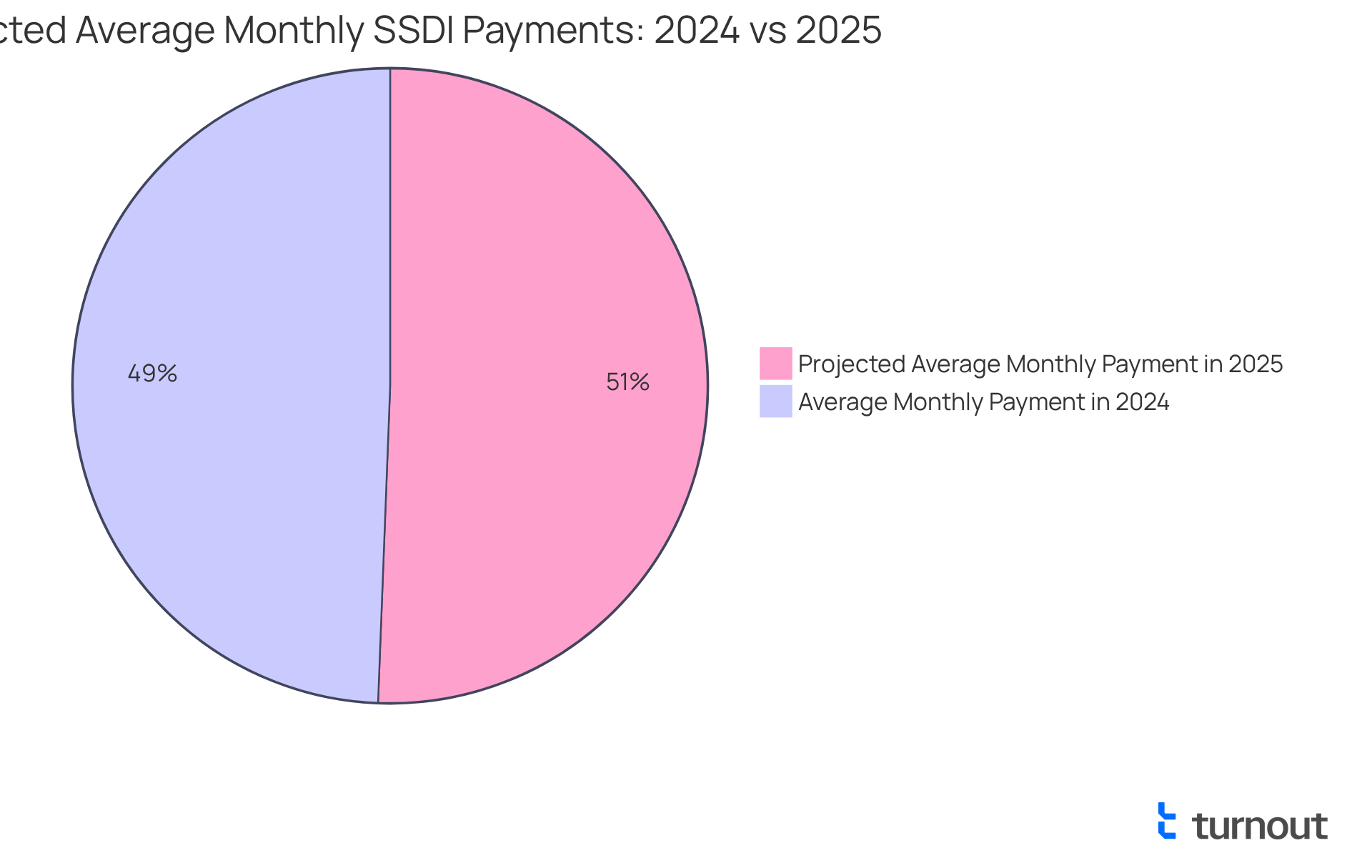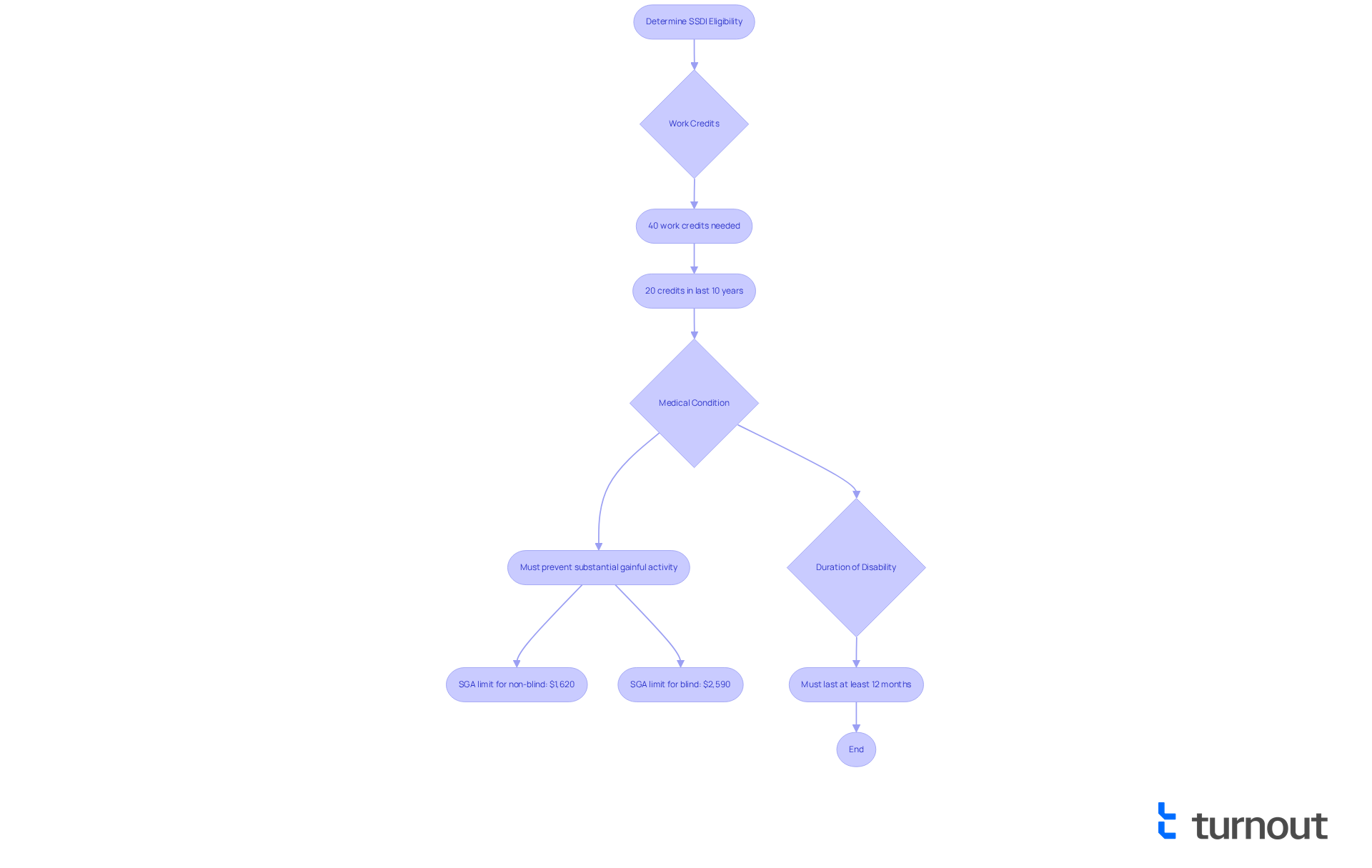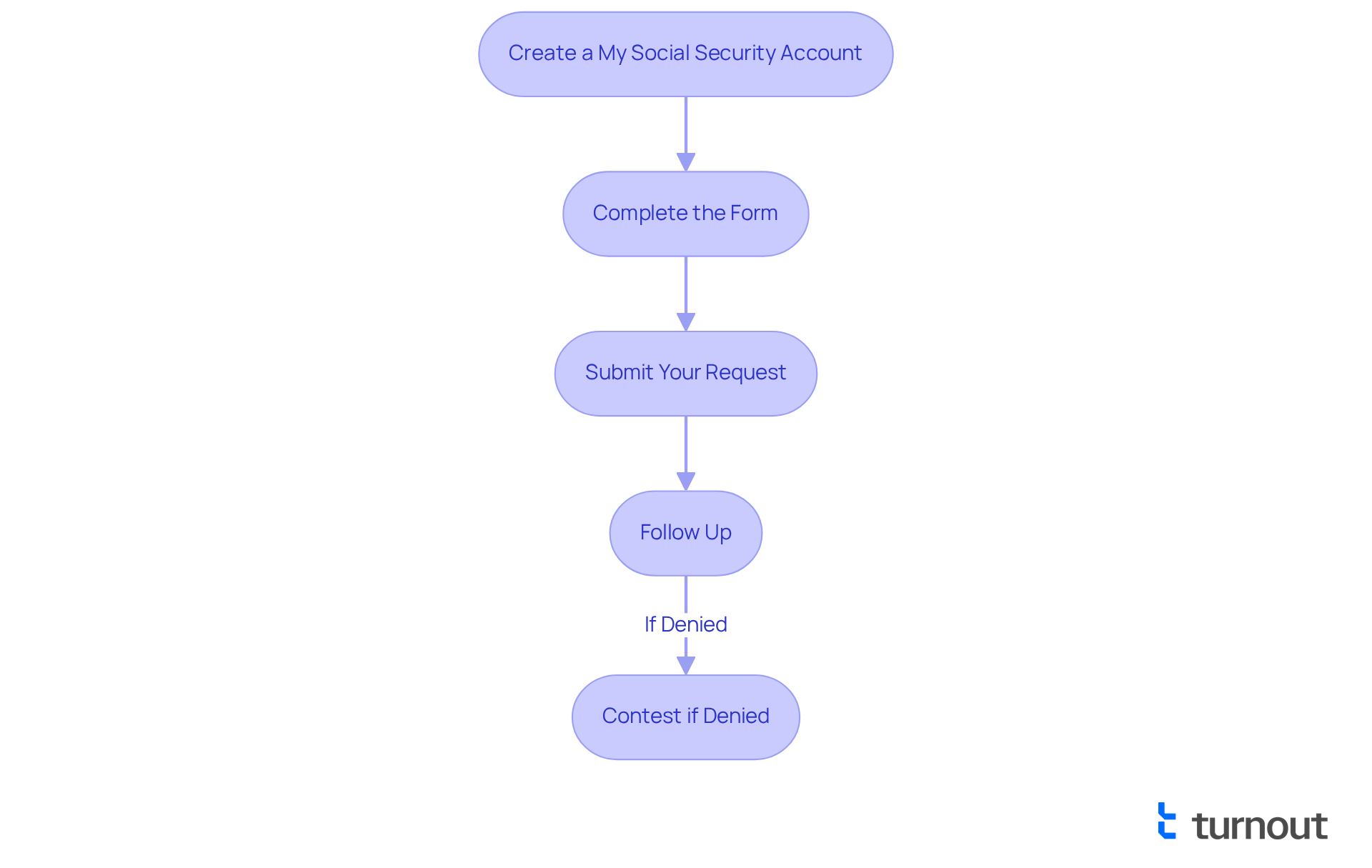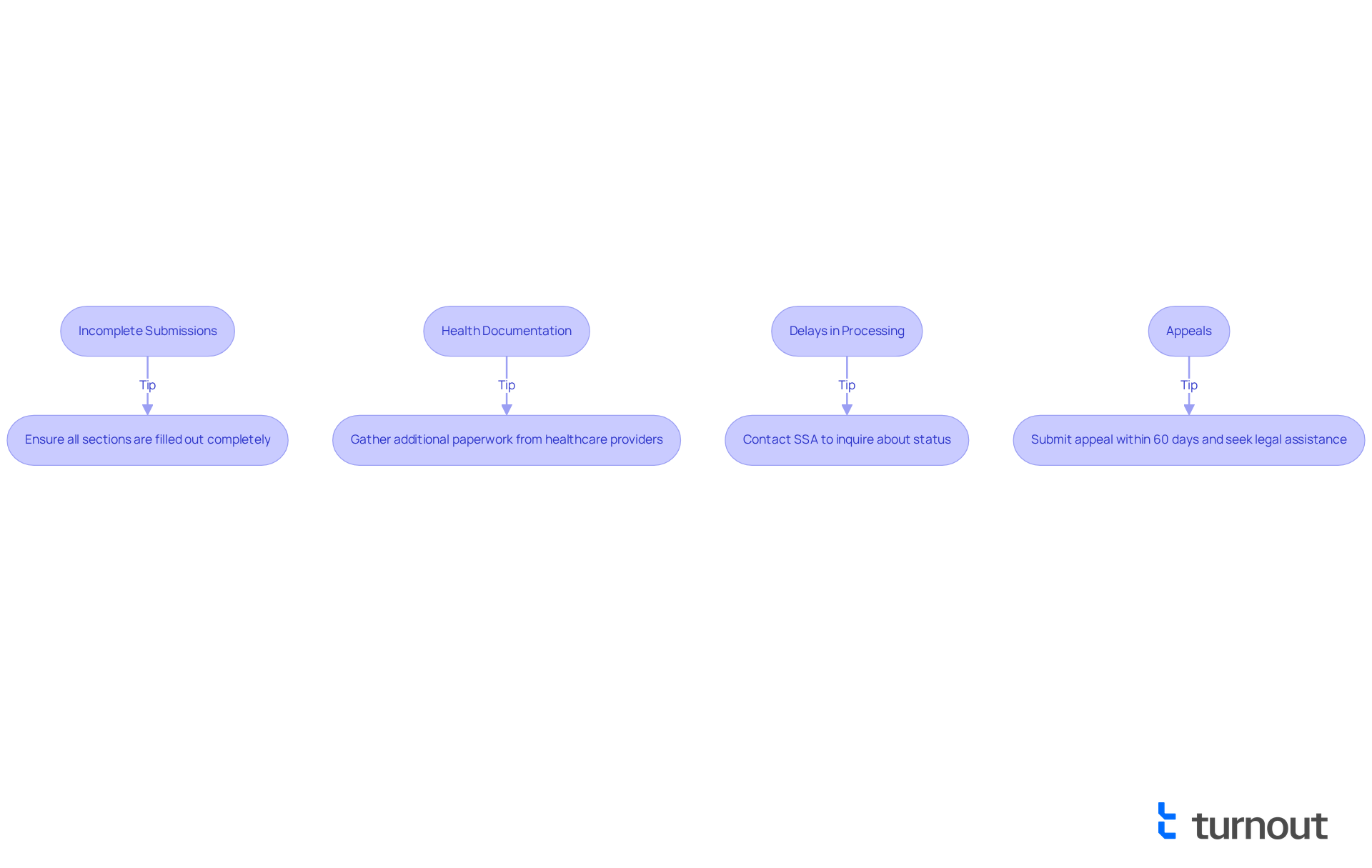Overview
Navigating the Social Security Disability Insurance (SSDI) application process can be overwhelming. We understand that many individuals face challenges when trying to secure the benefits they deserve. This article offers a comprehensive step-by-step guide to help you through this journey.
It's crucial to understand the eligibility criteria for SSDI. By gathering the necessary documentation and following specific application steps, you can significantly enhance your chances of approval. Many initial claims are denied due to incomplete submissions or inadequate medical documentation, but you're not alone in this. We’re here to help you every step of the way.
Take a moment to reflect on your situation. Are you feeling uncertain about what documents you need? Or perhaps you're worried about the application process? It's common to feel this way, and that’s why having a clear guide can make all the difference.
Remember, you have the power to change your circumstances. By following the steps outlined in this guide, you're taking a proactive approach to your SSDI application. We believe in your ability to navigate this process successfully, and we’re here to support you.
Introduction
Navigating the complexities of Social Security Disability Insurance (SSDI) can feel like an uphill battle for many individuals facing disabilities. We understand that with over 5 million Americans relying on this crucial financial support, the application process can seem daunting.
It's essential to grasp the steps involved to secure the benefits that can significantly enhance your quality of life. However, the journey is fraught with challenges. From meeting stringent eligibility criteria to gathering the necessary documentation, many hurdles can arise.
How can you effectively maneuver through these obstacles to ensure your claims are successful? You're not alone in this journey, and we're here to help.
Understand Social Security Disability Insurance (SSDI)
Social Security SSDI is a vital federal initiative that offers essential financial assistance to individuals who are unable to work due to qualifying disabilities. We understand that navigating this process can be challenging, and it’s important to know that help is available. To qualify, applicants must show a sufficient work history, earning the necessary work credits through prior employment.
In 2025, the average monthly disability payment is projected to rise to approximately $1,580, up from $1,542 in 2024, reflecting a 2.5% cost-of-living adjustment (COLA). This increase provides crucial support to those in need, helping cover living expenses, medical costs, and other essential needs during times of disability.
Consider this: an individual receiving $2,000 in disability support in 2024 might see their payment increase to $2,100 or higher in 2025. This extra financial assistance can make a significant difference. With more than 5 million Americans currently receiving social security ssdi, the program plays a vital role in supporting individuals facing the challenges of disability.
Financial advisors emphasize the importance of disability assistance for individuals with disabilities, noting that these resources can greatly alleviate financial pressure and enhance quality of life. As one advisor shared, "Disability support is crucial for many disabled individuals, offering them the financial security needed to focus on their health and recovery."
As the disability support program evolves, understanding its benefits and eligibility criteria is essential for successfully navigating the application process. We’re here to help you through this journey. Continuous efforts to simplify the disability claims process aim to reduce delays and improve access to assistance for all applicants. Remember, you are not alone in this journey.

Determine Your Eligibility for SSDI Benefits
Navigating the path to disability benefits can be challenging, and we want to ensure you understand the eligibility criteria. Here are the key points to consider:
-
Work Credits: Typically, you'll need to have earned 40 work credits. Importantly, at least 20 of those credits should be accumulated within the last 10 years before your disability began. In 2025, one credit is earned for every $1,690 in covered earnings. This means you must earn a minimum of $6,760 to obtain the maximum four credits for the year.
-
Medical Condition: Your disability must be severe enough to prevent you from engaging in substantial gainful activity (SGA). For 2025, the SGA limit is set at $1,620 per month for non-blind individuals and $2,590 for blind individuals. We understand that this can feel overwhelming, but knowing these figures is essential.
-
Duration of Disability: Your condition must be expected to last at least 12 months or result in death. If you're unsure about qualifying conditions, we encourage you to refer to the Social Security Administration's (SSA) Blue Book for a comprehensive list.
Understanding these requirements is crucial, as roughly two-thirds of initial disability claims are rejected, often due to inadequate documentation of work credits or medical proof. If your request is denied, remember that you can ask for a reconsideration within 60 days. You're not alone in this journey; we're here to help you every step of the way.

Gather Necessary Documentation for Your Application
To successfully prepare your application for social security SSDI, we understand that gathering comprehensive documentation can feel overwhelming. Here’s what you need to know:
- Personal Information: Start by including your Social Security number, birth certificate, and proof of U.S. citizenship or lawful alien status.
- Health Records: It’s important to compile detailed health records that clearly document your diagnosis, treatment history, and how your condition affects your ability to work, especially for social security ssdi eligibility. Social workers emphasize that thorough and precise health records are essential, as they can significantly improve the reliability of your claim. As one social worker noted, 'Thorough medical documentation is essential for substantiating a social security ssdi disability claim and can significantly impact the approval process.'
- Work History: Provide a complete employment history for the past 15 years, detailing the names and addresses of employers, job titles, and dates of employment.
- Financial Information: Gather relevant financial documents, such as tax returns or pay stubs, that may support your claim.
Having these documents arranged and prepared will not only simplify the submission process but also enhance your likelihood of approval. In fact, research indicates that roughly 70% of disability benefit requests submitted with complete documentation are more likely to be successful. Instances of successful implementations often highlight the importance of meticulous record-keeping and thorough preparation. By ensuring all required information is included, you can navigate the social security ssdi disability benefits process with greater confidence. Remember, it’s common to feel anxious about incomplete submissions, which can lead to delays or rejections. So, it’s essential to double-check that all necessary documentation is provided. You are not alone in this journey, and we’re here to help you every step of the way.

Navigate the SSDI Application Process Step-by-Step
Navigating the social security ssdi application process can feel overwhelming, but you’re not alone. Here are some essential steps to help you through this journey:
-
Create a My Social Security Account: Begin by visiting the SSA website to set up your account. This online portal will empower you to manage your submission efficiently and monitor its progress.
-
Complete the Form: Fill out the social security ssdi form (SSA-16) and the Adult Disability Report (SSA-3368). It’s crucial to be thorough and honest in your responses. Incomplete applications are a common reason for denials. Take your time to provide detailed information about your health conditions and how they impact your daily life. Organizing comprehensive medical records is vital for approval, so gather all necessary documentation in advance.
-
Submit Your Request: You can submit your request online, by phone, or in person at your local SSA office. Submitting online is often the most efficient method, allowing for quicker processing. Typically, requests submitted online take about 3-5 months to process.
-
Follow Up: After submission, keep an eye on your status through your My Social Security account. Be ready to respond promptly to any requests for additional information from the SSA. Timely communication can significantly expedite the process. Remember, frequent mistakes in applications for social security ssdi often involve sending incomplete forms and not providing a thorough list of health conditions.
Real-life experiences show that applicants who meticulously gather their medical records and provide comprehensive documentation tend to have better outcomes. For instance, individuals who included detailed remarks from their healthcare providers regarding their conditions and limitations have successfully navigated the disability benefits process. If your request is denied, don’t be disheartened—you have the right to contest it. Many claims succeed upon contestation. Keep in mind that more than half of all initial disability claims are rejected, often due to inadequate medical documentation or incomplete details. This makes thoroughness essential.
We’re here to help you every step of the way.

Troubleshoot Common Application Challenges
Applying for disability benefits can be a challenging journey, and it's important to know you're not alone in this process. Here are some supportive tips to help you navigate common challenges:
-
Incomplete Submissions: It’s crucial to ensure that all sections of your form are filled out completely. Did you know that over 60% of requests for social security ssdi are initially rejected due to insufficient information? Take a moment to verify that no details are missing before you hit submit.
-
Health Documentation: If your request is denied because of inadequate health documentation, we encourage you to gather additional paperwork from your healthcare providers. This should clearly describe your condition and limitations. Remember, updating your medical records to reflect any worsening conditions is vital for strengthening your appeal.
-
Delays in Processing: Encountering delays can be frustrating. If this happens, don't hesitate to reach out to the SSA to inquire about the status of your request. Keeping a record of all communications can be incredibly helpful during this time.
-
Appeals: If your application is denied, it’s easy to feel discouraged. However, you have the right to appeal this decision related to social security ssdi! Follow the instructions in your denial letter and remember to submit your appeal within the 60-day timeframe. Seeking assistance from a disability lawyer can significantly enhance your chances of a favorable ruling. Successful appeals often depend on presenting new medical evidence or clarifying existing documentation, so be prepared to strengthen your case.
We understand that this process can be overwhelming, but we’re here to help you every step of the way. You are not alone in this journey.

Conclusion
Navigating the Social Security Disability Insurance (SSDI) application process can feel overwhelming. Yet, it is a vital step for those seeking financial support due to disabilities. We understand that understanding eligibility requirements, gathering necessary documentation, and following a structured application process can significantly impact your claim's outcome. With the right preparation and knowledge, you can enhance your chances of receiving the assistance you need.
In this guide, we’ve shared essential insights, including:
- The importance of work credits
- The severity and duration of medical conditions
- The necessity of comprehensive documentation
It’s common to feel discouraged, especially when statistics show that many initial claims are denied due to incomplete information or inadequate medical evidence. By meticulously preparing your application and being aware of common challenges, you can navigate the SSDI process more effectively.
Remember, the journey to securing SSDI benefits is not one you must face alone. With resources available and the possibility of appealing denied claims, we encourage you to persist in your efforts. Taking proactive steps—such as consulting with professionals, ensuring thorough documentation, and remaining informed about the application process—can make a significant difference in achieving a favorable outcome. The support provided by SSDI is invaluable, and understanding how to access it is crucial for you. You are not alone in this journey; we’re here to help.
Frequently Asked Questions
What is Social Security Disability Insurance (SSDI)?
SSDI is a federal program that provides financial assistance to individuals who are unable to work due to qualifying disabilities.
What are the eligibility requirements for SSDI benefits?
To qualify for SSDI, applicants must have earned 40 work credits, with at least 20 credits accumulated in the last 10 years before the disability began. Additionally, the disability must prevent substantial gainful activity (SGA) and be expected to last at least 12 months or result in death.
What are work credits and how can they be earned?
Work credits are earned through prior employment, with one credit earned for every $1,690 in covered earnings in 2025. A maximum of four credits can be earned per year, requiring a minimum of $6,760 in earnings.
What is the SGA limit for 2025?
The SGA limit for 2025 is set at $1,620 per month for non-blind individuals and $2,590 for blind individuals.
What happens if my SSDI application is denied?
If your SSDI application is denied, you can request a reconsideration within 60 days. It's important to ensure that you have adequate documentation of work credits and medical proof to support your claim.
How much financial assistance can I expect from SSDI?
In 2025, the average monthly disability payment is projected to be approximately $1,580, reflecting a 2.5% increase from 2024. Payments can vary based on individual circumstances, with potential increases for those already receiving benefits.
Why is disability assistance important?
Disability assistance is crucial for individuals with disabilities as it alleviates financial pressure, enhances quality of life, and allows them to focus on health and recovery.
What resources are available to help with the SSDI application process?
Continuous efforts are being made to simplify the disability claims process, and there are resources available to help individuals navigate the application process. You are encouraged to seek assistance if needed.




